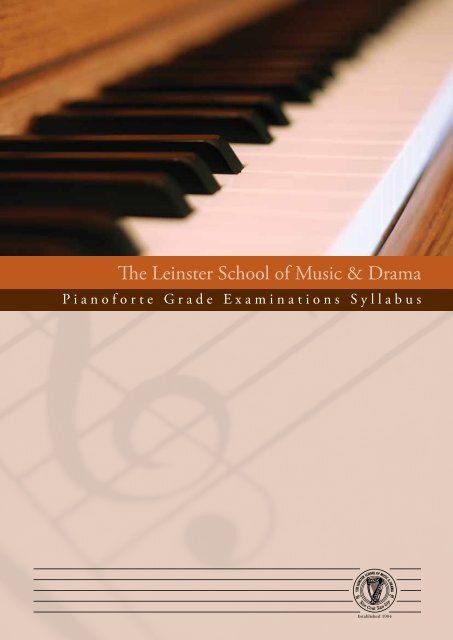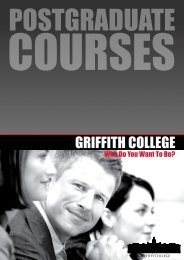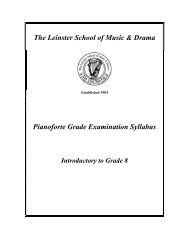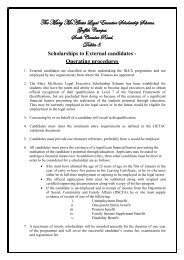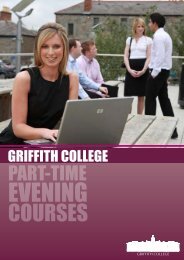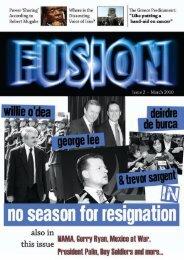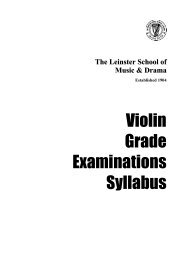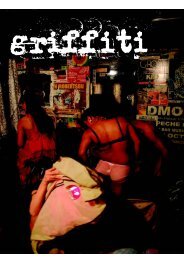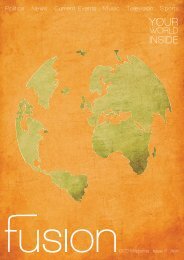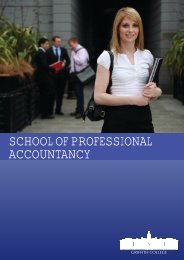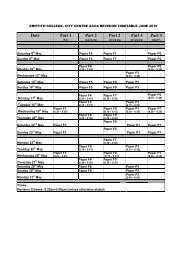The Leinster School of Music & Drama - Griffith College Dublin
The Leinster School of Music & Drama - Griffith College Dublin
The Leinster School of Music & Drama - Griffith College Dublin
- No tags were found...
You also want an ePaper? Increase the reach of your titles
YUMPU automatically turns print PDFs into web optimized ePapers that Google loves.
<strong>The</strong> <strong>Leinster</strong> <strong>School</strong> <strong>of</strong> <strong>Music</strong> & <strong>Drama</strong>Pian<strong>of</strong>orte Grade Examinations SyllabusEstablished 1904
<strong>The</strong> <strong>Leinster</strong> <strong>School</strong> <strong>of</strong> <strong>Music</strong> & <strong>Drama</strong>Pian<strong>of</strong>orte Grade Examination SyllabusGeneral InformationThis handbook is designed to help clarify the requirements <strong>of</strong> the new syllabus. Teachers should at all times consultthe syllabus for the requirements such as scales, sight reading and aural tests.This syllabus has been framed taking into account current educational thinking and research, and provides asystematic progression through the grades in preparation for Diploma examinations at a later stage.This syllabus works in conjunction with the studies, exercises, sight reading and aural tests in the Piano GradeSyllabus & Teachers Handbook (available in hard copy and online at www.gcd.ie/music-syllabuses).Exam Regulations• Grade examinations are marked out <strong>of</strong> 100 and candidates must secure 65 marks overall to pass. Candidatesscoring 87 marks or over will be awarded 1st class honours, 80 to 86 will be deemed to have passed withhonours and 70 to 79 will be deemed to have passed with merit.• A medal will be awarded to a candidate who has gained 95 marks or more overall in any grades fromPreparatory to Grade 8.• In all examinations, prepared pieces may be heard in full or in part at the discretion <strong>of</strong> the examiner.• Candidates must adhere strictly to the repertoire in the syllabus. Where there is an own choice option, thisapplies to one piece only <strong>of</strong> the programme. If this chosen piece is not at the relevant grade level 5 pointswill be deducted.• <strong>The</strong> editions listed in the syllabus are suggested editions. Alternative editions <strong>of</strong> similar standing are equallyacceptable. However, easier arrangements <strong>of</strong> the same pieces will not be accepted.• Candidates are not compelled to adhere to the fingering indicated in any <strong>of</strong> the pieces. Any appropriatefingering will be accepted.• Scales should be fingered in accordance with recommendations. At examinations marks will be deductedfor inappropriate fingering• No photocopied music is allowed at any time, except for awkward page turns.• Candidates presenting themselves for examination in any 2012 session may present either the old or thenew syllabus. From January 1st 2013 only the new syllabus will be accepted.3
<strong>The</strong> <strong>Leinster</strong> <strong>School</strong> <strong>of</strong> <strong>Music</strong> & <strong>Drama</strong>Pian<strong>of</strong>orte Grade Examination SyllabusRationale for the New SyllabusIn 2004 the <strong>Leinster</strong> <strong>School</strong> <strong>of</strong> <strong>Music</strong> and <strong>Drama</strong> celebrated its centenary with an update <strong>of</strong> its syllabus. <strong>The</strong> pastdecade has seen an explosion in the understanding <strong>of</strong> musical ability and learning; it was felt that the time had comefor a further review <strong>of</strong> the content and the introduction <strong>of</strong> some new ideas to meet the needs <strong>of</strong> the new decade.Following consultations with a variety <strong>of</strong> teachers and examiners the new syllabus has been launched, taking intoaccount the many views expressed by interested parties. Above all, the new syllabus recognises that not all learnersare the same, and takes into account the capacity <strong>of</strong> teachers at local level to assess and cater for individual learnerneeds.<strong>The</strong> new programme has a number <strong>of</strong> innovative ideas:• <strong>The</strong> repertoire has been broadened to include a wide range <strong>of</strong> contemporary genres. This reflects the broaderacceptance <strong>of</strong> styles other than classical pieces in music teaching and learning.• Recent research in the areas <strong>of</strong> teaching and learning indicates that students are motivated by appropriatechoice in their own learning. With this in mind it has been decided to include a choice option for theperformance pieces. It has also been decided to give students further choices in the higher grades relatingto developing their technical skills and musicianship.• Aural awareness has been remodelled with the objective <strong>of</strong> developing a critical ear which can discern variousaspects <strong>of</strong> performance. Students will study time names at the earlier grades which will develop their rhythm,and in turn, enhance their aural and sight reading skills. <strong>The</strong> French, Kodaly and Orff time name systems arerecommended but others will also be accepted.• Bearing in mind that some students wish to become independent musicians as well as progressing throughthe grade system, the option <strong>of</strong> improvisation/keyboard harmony has been introduced at the higher grades.This will support their participation in musical environments outside <strong>of</strong> the classroom or lesson.• Students at a higher grade are expected to research composers and their works as part <strong>of</strong> their exam whichis also reflective <strong>of</strong> the information age we live in.A broad list <strong>of</strong> repertoire has been included to suit all levels and tastes. Through this new syllabus, the <strong>Leinster</strong> <strong>School</strong><strong>of</strong> <strong>Music</strong> and <strong>Drama</strong> intends to continue to provide a supportive environment to enhance the development <strong>of</strong> musiceducation for both teachers and students in the years ahead.Marking scheme for all pian<strong>of</strong>orte examsMarkAward(a) Technical studies 15(b) Sight reading & comprehension 15(c) Aural observation 10(d) Performance (3 x 20) 6065 – 70 Pass70 – 79 Merit80 – 86 Honours87 – 100 First Class Honours4
Hitting a Higher Note! at GRIFFITH COLLEGEHigher diploma in Arts in <strong>Music</strong> Education<strong>The</strong> <strong>Leinster</strong> <strong>School</strong> <strong>of</strong> <strong>Music</strong> & <strong>Drama</strong> is delighted to announcethe launch <strong>of</strong> a Higher Diploma in Arts in <strong>Music</strong> Education, and associatedCertificates in <strong>Music</strong> Teaching.Your music studies need not stop at Grade 8! <strong>The</strong>se HETAC approved(Level 8) will enable instrumental students to embark in a wide range <strong>of</strong>careers in music education, or progress to further education in musictechnology, music therapy, arts administration and music teaching.Courses Higher diploma in Arts in <strong>Music</strong> Education (HETAC Level 8) Certificate in <strong>Music</strong> Teaching – HETAC 40 credits (Licentiate <strong>of</strong> the LSMD) Certificate in <strong>Music</strong> Teaching – HETAC 20 credits (Associate <strong>of</strong> the LSMD)A range <strong>of</strong> options are open to you… Taught options in <strong>Dublin</strong> and Cork Full-time and part-time delivery modes A choice <strong>of</strong> morning and evening lectures,combined with block releaseFor further information contact:<strong>The</strong> <strong>Leinster</strong> <strong>School</strong> <strong>of</strong> <strong>Music</strong> & <strong>Drama</strong>,<strong>Griffith</strong> <strong>College</strong> South Circular Road, <strong>Dublin</strong> 8Established in 1904Email: leinster.school@gcd.ie | Web-site: www.gcd.ie/lsmdPhone: (01) 4150466 (<strong>Dublin</strong>) | (021) 4507027 (Cork)
<strong>The</strong> <strong>Leinster</strong> <strong>School</strong> <strong>of</strong> <strong>Music</strong> & <strong>Drama</strong>Pian<strong>of</strong>orte Grade Examination SyllabusIntroductory GradeAims for the TeacherTo introduce the student to the pleasure <strong>of</strong> playing music, instillinga love and enthusiasm for all aspects <strong>of</strong> the process, and layingsound foundations through the development <strong>of</strong> aural, reading,technical and performance skills at an elementary level.SCHEDULE OF MAXIMUM MARKSTechnical Studies 15Sight-Reading & Comprehension 15Aural Observation 10Pieces 1 202 203 20Learning Outcomes for the Student• Understand the basics <strong>of</strong> notation and recognise notes in the treble and bass clefs.• Have a proper hand position in both hands and be able to play legato and staccato.• Acquire a proper seated position.• Understand elementary rhythmic patterns, including crotchets, quavers and minims.• Sing very simple melodic motifs.• Be able to perform a selection <strong>of</strong> pieces at introductory level.Course Content:(a)Technical Studies:• Scales <strong>of</strong> C and G major, one octave hands separately.• Chords <strong>of</strong> C and G major (refer to Teachers’ Handbook)• Five finger exercise, hands together over middle C.(refer to Teachers’ Handbook)(b)Sight reading and Comprehension:• Understanding the treble and bass clefs.• Identifying and locating notes from prepared pieces in treble and bass clefs.• Answer simple questions on bar lines, note and rest values in the prepared pieces.(c)Aural Observation:• To recognise two notes played by the examiner as being either ascending or descending (rising or falling,up or down)• Identifying a short phrase from one <strong>of</strong> the prepared pieces.• To clap back a short rhythm played twice by the examiner.• To sing back a short sequence <strong>of</strong> notes played twice by the examiner.(for examples <strong>of</strong> aural observation tests refer to Teachers’ Handbook)6
<strong>The</strong> <strong>Leinster</strong> <strong>School</strong> <strong>of</strong> <strong>Music</strong> & <strong>Drama</strong>Pian<strong>of</strong>orte Grade Examination Syllabus(d)Performance:Three pieces from the following list:<strong>Music</strong> Lessons Have Begun(Lelia Fletcher, Boston <strong>Music</strong> Company)Piano Time Pieces 1(Pauline Hall, Oxford University Press)John Thompson Easiest Piano Course(John Thompson, Willis <strong>Music</strong> Company)Teach me to Play. Preliminary Book(Howard Kasschau, Schirmer)Teaching Little Fingers to Play(John Thompson, Willis <strong>Music</strong> Co.)<strong>The</strong> DucklingCampfire MarchCanoe SongHalloween PumpkinEvening Hymn*What shall I sing?*Morning Has Broken*Frog CountGrass So Green<strong>The</strong>me from the CreationMinuet in GSonatinaCan-CanOur Old ClockMy PrayerIce Cream MountainPaper Ships*Toy Soldiers**<strong>The</strong>se Pieces are recommended for the very young beginner7
<strong>The</strong> <strong>Leinster</strong> <strong>School</strong> <strong>of</strong> <strong>Music</strong> & <strong>Drama</strong>Pian<strong>of</strong>orte Grade Examination SyllabusPrimary GradeAims for the TeacherTo build on the foundational skills acquired at introductory level,through broadening repertoire, and facilitating the incrementaldevelopment <strong>of</strong> aural, reading, musicianship and technical abilitiesat primary level.SCHEDULE OF MAXIMUM MARKSTechnical Studies 15Sight-Reading & Comprehension 15Aural Observation 10Pieces 1 202 203 20Learning Outcomes for the Student• Understand notation in both staves and up to one ledger line above and below each stave.• Demonstrate a basic knowledge <strong>of</strong> time names (crotchet, quavers and minims). French, Kodaly, Orff or othertime name systems will be accepted.• Perform a selection <strong>of</strong> pieces <strong>of</strong> suitable standard, in the keys <strong>of</strong> C, G and F majors, and A minor.• Sing simple melodic phrases in the range <strong>of</strong> a 5th.• Demonstrate an awareness <strong>of</strong> dynamic contrasts.Course Content:(a)Technical Studies:• Scales <strong>of</strong> C, G, F majors, one octave hands separately.Chords <strong>of</strong> the above keys in close position, hands separately (refer to Teachers’ Handbook)• Preparation <strong>of</strong> four musical sentences from a recommended list (refer to Teachers’ Handbook). Candidateswill be required to perform one <strong>of</strong> the musical sentences at the examination.(b)Sight reading and Comprehension:• Understanding the treble and bass clef and one ledger line above and below both staves together with thesharp and flat.• Explaining bar lines, time signatures, note values and marks <strong>of</strong> expression in the prepared pieces.• Understanding the difference between a tone and semi-tone, and pointing out the tones and semi tones inthe scale <strong>of</strong> C major.(c)Aural Observation:• To clap at sight a two bar phrase consisting <strong>of</strong> crotchets, quavers and minims using time names. French,Kodaly, Orff or other time name systems will be accepted.• To clap back a short phrase played by the examiner.• Sing back a two bar phrase played twice by the examiner.(for examples <strong>of</strong> aural observation tests refer to Teachers’ Handbook)8
<strong>The</strong> <strong>Leinster</strong> <strong>School</strong> <strong>of</strong> <strong>Music</strong> & <strong>Drama</strong>Pian<strong>of</strong>orte Grade Examination SyllabusPreparatory GradeAims for the TeacherTo consolidate the student’s foundation in elementary technique,musicianship, reading and aural skills, in preparation for progressingon to grades 1-8.SCHEDULE OF MAXIMUM MARKSTechnical Studies 15Sight-Reading & Comprehension 15Aural Observation 10Pieces 1 202 203 20Learning Outcomes for the Student• Recognise notes in the treble and bass clefs up to one ledger line above and below the stave, or any notesin the chosen pieces.• Sight-read short phrases, hands separately, beginning on middle C.• Clap rhythms by ear and sight, using time names (crotchet, quavers, minims and crotchet rests). French,Kodaly, Orff or other time name systems will be accepted.• Perform a selection <strong>of</strong> pieces <strong>of</strong> suitable standard in the keys <strong>of</strong> C, G and F majors, and A minor.• Demonstrate an awareness <strong>of</strong> dynamic rangeCourse Content:(a)Technical Studies:• Scales <strong>of</strong> C, G and F majors, A and D minors, one octave hands separately.• Three note close position chords <strong>of</strong> the above keys hands separately (refer to Teachers’ Handbook).• Preparation <strong>of</strong> two musical sentences (refer to Teachers’ Handbook).(b)Sight reading and Comprehension:• Recognising time signatures, key signatures and expression marks in the prepared pieces.• Sight reading a short passage containing mainly stepwise movement over the five fingers, right hand andleft hand separately, both positioned on middle C.• Construction <strong>of</strong> the major scale, identifying tones and semi-tones, in the scales <strong>of</strong> C and G.(c)Aural Observation:• To clap at sight a short phrase in 4/4 using time names (minims, crotchets, quavers and crotchet rests).French, Kodaly, Orff or other time name systems will be accepted• Sing back a short melody played by the examiner within the range <strong>of</strong> a 5th• To clap along to a short passage played by the examiner in 2/4 or 3/4.(for examples <strong>of</strong> aural observation tests refer to Teachers’ Handbook)10
<strong>The</strong> <strong>Leinster</strong> <strong>School</strong> <strong>of</strong> <strong>Music</strong> & <strong>Drama</strong>Pian<strong>of</strong>orte Grade Examination SyllabusGrade 1Aims for the TeacherTo foster enthusiasm for music, and to encourage the student todevelop the practical and technical skills to perform at this level. Tobroaden the student’s exploration <strong>of</strong> performance, listening, andmusicianship, through the introduction <strong>of</strong> new repertoire including classical, jazz and contemporary.Learning Outcomes for the Student• Be able to perform pieces over a wide range <strong>of</strong> the keyboard.• Play at least one <strong>of</strong> the pieces from memory (optional).• Understand the concept <strong>of</strong> major and minor keys.• Sight read a short piece using both hands, but with mainly hands separate movement, in keys up to onesharp or one flat,• Sing a short phrase after hearing it, and be able to identify the difference between 2/4 and 3/4.Course Content:SCHEDULE OF MAXIMUM MARKSTechnical Studies 15Sight-Reading & Comprehension 15Aural Observation 10Pieces 1 202 203 20(a)Technical Studies:• Scales <strong>of</strong> C, G, D, A and F majors. A and D minors, two octaves hands separately and one octave handstogether.• Contrary motion one octave in the keys <strong>of</strong> C and G majors.• Three note broken chords and inversions <strong>of</strong> C and G majors, A and D minors. (refer to Teachers’ Handbook).(b)Sight reading and Comprehension:• To sight read a short passage with each hand separately in the key <strong>of</strong> C or G• To answer questions on dynamic and performance directions in the prepared pieces.• Identifying various Intervals in the prepared pieces up to and including a 5th, which will include a major 2nd,major 3rd. perfect 4th and perfect 5th.(c)Aural Observation:• To clap a rhythm at sight in 4/4 using time names (minims, crotchets, quavers, semiquavers, minim andcrotchet rests). French, Kodaly, Orff or other time name systems will be accepted.• To clap back the rhythm <strong>of</strong> a melody played twice by the examiner.• To sing back a short melody played twice by the examiner.• To identify the time <strong>of</strong> a short piece played by the examiner as being in either 2/4 or 3/4.(for examples <strong>of</strong> aural observation tests refer to Teachers’ Handbook)12
<strong>The</strong> <strong>Leinster</strong> <strong>School</strong> <strong>of</strong> <strong>Music</strong> & <strong>Drama</strong>Pian<strong>of</strong>orte Grade Examination Syllabus(d)Performance:Performance <strong>of</strong> three pieces, as least two <strong>of</strong> which must be from the attached list. <strong>The</strong> third piece may alsobe selected from the list or may be the candidate’s own choice, which must be <strong>of</strong> at least equal standard tothe pieces on the prescribed list (please see guidelines for own choice piece in Appendix 1).Young Pianists Repertoire Book 1(Fanny Watermann & Marion Harewood, Faber <strong>Music</strong>)Piano Time Pieces 2(Pauline Hall, Oxford University Press<strong>The</strong> Best <strong>of</strong> Grade 1 Piano(Faber <strong>Music</strong>)Up Grade 1 – 2(Faber <strong>Music</strong>)Swinging Rhymes(Terence Greaves, ABRSM)Step by Step to the Classics(Felix Swinstead, Banks <strong>Music</strong> Publication)Micro Jazz Collection I, Level 3(Christopher Norton, Boosey and Hawkes)Nannerl’s Minuet (Mozart)Waltz (Shostakovitch)Tarantella (Hall)Gavotte (James Hook)Sonatina No. 3 in F (Atwood)Quasi Adagio (Bela Bartok)Air (John Blow)Creepy Crawly (Peter Gritton)Piano Piece for the Young (Heinrich Henkel)Eeyore’s March (Tim Jackson)Allegretto (Chriptoph Neefe)Gavotte (Georg Telemann)Mad Hatter’s Funeral MarchCool CalypsoThree Blue MiceBaa, Baa, Blue SheepA little Piece (Schumann)Allegretto in F (Berins)Polonaise (Richard Jones)Tut-TuttinA Winter Song13
<strong>The</strong> <strong>Leinster</strong> <strong>School</strong> <strong>of</strong> <strong>Music</strong> & <strong>Drama</strong>Pian<strong>of</strong>orte Grade Examination SyllabusGrade 2Aims for the TeacherTo continue to inspire a love <strong>of</strong> music making through a learnercentered approach to performance. To encourage the student toengage as a participant in his or her own musical development232020through fostering their technical and musicianship skills i.e. through cultivating and encouraging practice routineswhich are required for increased technical and musical development.Learning Outcomes for the Student• Be able to perform pieces over a wide range <strong>of</strong> the keyboard in different styles• Be able to perform at least one <strong>of</strong> the pieces from memory.• Understand major and minor tonalities.• Sight-read using both hands together in the keys <strong>of</strong> C, F and G.• Demonstrate greater aural awareness in responding to aural stimuli and identifying aspects <strong>of</strong> piecesperformed.Course Content:SCHEDULE OF MAXIMUM MARKSTechnical Studies 15Sight-Reading & Comprehension 15Aural Observation 10Pieces 1 20(a)Technical Studies:• Scales <strong>of</strong> D, A, E, B and F majors, E, D and B minors, 2 octaves hands together.• Contrary motion one octave in the keys <strong>of</strong> D, A and E majors, and D and E minors, beginning and ending onthe key note.• Chromatic scale beginning on C and C sharp, one octave hands separately.• Arpeggios <strong>of</strong> the above keys, major and minor, two octaves, hands separately(b)Sight reading and Comprehension:• To sight read short passages, hands together, in the keys <strong>of</strong> C, G or F major.• To answer questions on dynamic and performance directions in the prepared pieces.• To identify major and minor chords (root position) in the prepared pieces.• To give a short description <strong>of</strong> the candidate’s favourite piece <strong>of</strong> the three performed. Questions will relate tothe style <strong>of</strong> the piece (classical/popular/jazz etc.) and the reasons for their choice.(c)Aural Observation:• To clap back the rhythm <strong>of</strong> a short melody in 2/4, 3/4 or 4/4 played twice by the examiner and to statewhether it was in 2/4, 3/4 or 4/4.• To sing back a short melody played twice by the examiner.• To listen to two notes played by the examiner, separately and together, and identify the interval as major 2nd,major 3rd, perfect 4th or perfect 5th.14
<strong>The</strong> <strong>Leinster</strong> <strong>School</strong> <strong>of</strong> <strong>Music</strong> & <strong>Drama</strong>Pian<strong>of</strong>orte Grade Examination Syllabus• To listen to a short piece played by the examiner and identify obvious features i.e. whether the piece wasplayed forte or piano, legato or staccato, with a rall at the end etc.(for examples <strong>of</strong> aural observation tests refer to Teachers’ Handbook)(d)Performance:Performance <strong>of</strong> three pieces, as least two <strong>of</strong> which must be from the following list. <strong>The</strong> third piece may alsobe selected from the list or may be the candidates own choice, which must be <strong>of</strong> at least equal standard tothe pieces on the prescribed list (see guidelines for own choice piece in Appendix 1).Young Pianist Repertoire, Book 1(Fanny Watermann & Marion Harewood, Faber)<strong>Music</strong> through Time, Book 2(Pauline Hall, Paul Harris, Oxford University Press)Up Grade, Grades 1 & 2(Pamela Wedgewood, Faber)Short Romantic Pieces for Piano, Book 2(ABRSM)<strong>Music</strong> through Time, Book 1(Pauline Hall, Paul Harris, Oxford University Press)More Classics to Moderns 2(Yorktown <strong>Music</strong> Press)Making the Grade,Grade 2(Chester <strong>Music</strong>)Young Pianists Repertoire, Book 2(Faber <strong>Music</strong>)Short Romantic Pieces for Piano, Book 1(ABRSMHours with the Masters Pre Grade 2(Bosworth)Cool Piano, Book 2(Kevin Mayhew)Waltz <strong>of</strong> Beauty and the Prince (Maurice)Old French Song (Tchaikovsky)Tarantella (Burgmuller)Homework BluesCharlestonClowning (Kabalevsky)Swinging Along (Muller)Night Journey (Gurlitt)Bagatelle (Diabelli)Sonatina (Salutrinskaya)Jean de Florette <strong>The</strong>me (Petit)ClocksTwo pieces for <strong>Music</strong>al Clocks (Haydn)Sonatina, 1st movement (Clementi)Study in A minor (Beyer)Prelude (Reinecke)Waltz (Dyson)Andantino (Mayer)Minuet and Trio (Haydn)Tick Tock Tango15
<strong>The</strong> <strong>Leinster</strong> <strong>School</strong> <strong>of</strong> <strong>Music</strong> & <strong>Drama</strong>Pian<strong>of</strong>orte Grade Examination SyllabusGrade 3Aims for the TeacherTo continue the student’s development in performance and tobroaden further their understanding <strong>of</strong> various musical styles. T<strong>of</strong>urther cultivate the skills required for independence as a musician,including playing by ear, memorizing, sight-reading, musicianship and technical skills.Learning Outcomes for the Student• Be able to perform a wide repertoire <strong>of</strong> pieces <strong>of</strong> a suitable standard to a high level <strong>of</strong> musicality.• Be able to perform at least one piece from memory.• Demonstrate a good understanding <strong>of</strong> major, minor and chromatic scales.• Sight-read hands together in major and minor keys up to one sharp and one flat.• Demonstrate an ability to respond to rhythmic and melodic stimuli and be able to identify the musical features<strong>of</strong> a previously unheard piece <strong>of</strong> music.Course Content:SCHEDULE OF MAXIMUM MARKSTechnical Studies 15Sight-Reading & Comprehension 15Aural Observation 10Pieces 1 202 203 20(a)Technical Studies:• Scales <strong>of</strong> B, F, B flat, E flat, A flat majors, G and C harmonic minors, two octaves hands together.• Scales <strong>of</strong> D, A and F majors, G and C minors, in contrary motion two octaves.• Arpeggios <strong>of</strong> the above major and minor keys, two octaves hands together.• Chromatic scale beginning on B and B flat, two octaves hands together(b)Sight reading and Comprehension:• To sight read a short passage hands together in the keys <strong>of</strong> C, G or F major, A or D minor.• To answer general questions on the pieces prepared for performance i.e. dynamics, articulation, mood etc.• To discuss a few short points on the style <strong>of</strong> one <strong>of</strong> the pieces (classical, jazz, popular etc.) relating particularlyto its musical features i.e. rhythm etc.• To identify major and minor chords root position in the prepared pieces.(c)Aural Observation:16• To clap back the rhythm <strong>of</strong> a short phrase played twice by the examiner, and to state whether the extract isin 3/4, 4/4 or 6/8.• To sing back a short melody played twice by the examiner• To identify major and perfect intervals up to an octave, plus the minor 3rd. <strong>The</strong>se intervals will be playedseparately and together.• After hearing a short piece played twice by the examiner, to comment on musical features such as major orminor tonalities, dynamic variations, articulation etc.(for examples <strong>of</strong> aural observation tests refer to Teachers’ Handbook)
<strong>The</strong> <strong>Leinster</strong> <strong>School</strong> <strong>of</strong> <strong>Music</strong> & <strong>Drama</strong>Pian<strong>of</strong>orte Grade Examination Syllabus(d)Performance:Performance <strong>of</strong> three pieces, as least two <strong>of</strong> which must be from the attached list. <strong>The</strong> third piece may alsobe selected from the list or may be the candidate’s own choice, which must be <strong>of</strong> at least equal standard tothe pieces on the prescribed list.Keyboard Anthology Third Series, Book 2(ABRSM)Keyboard Anthology Second Series, Book 2(ABRSM)Classics to Modern Book 3(Yorktown <strong>Music</strong> Press)Making the Grade Book 3(Chester <strong>Music</strong>)Up Grade, Grades 1– 2(Pam Wedgewood, Faber)Sound Works SeriesPick up pieces for Young Pianists, 1994(Philip Martin, Contemporary <strong>Music</strong> Centre)Sea Pink (Gurlitt)Allegro in F (Mozart)<strong>The</strong> New Doll (Tchaikovsky)Melody (Khachaturian)Puppets Complaint (Franck)If I were a Rich Man (Bock)Schindler’s List (John Williams)Half-a-Minute WaltzHubble BubbleCanon<strong>The</strong> Sad BoyClementi Edition Peters Sonatine OP. 36 No. 2(2nd movement)Short Romantic Pieces for Piano Book 1(ABRSM)Cool Piano 3 – Heather Hammond(Kevin Mayhew)Hours with the Masters Book 2(Bosworth)A Fairy Story (Kullak)Night in the Woods (Gedike)That’s the way to jazz it<strong>The</strong> Railroad BluesMinuet and Trio (Mozart)Scherzo (Bertini)Diversions Diversions No. 1 or 4(Richard Rodney Bennett, Universal)Piano Time Jazz Book 2(Pauline Hall, Oxford University Press)Tango Argentina17
<strong>The</strong> <strong>Leinster</strong> <strong>School</strong> <strong>of</strong> <strong>Music</strong> & <strong>Drama</strong>Pian<strong>of</strong>orte Grade Examination SyllabusGrade 4Aims for the TeacherTo continue the student’s development in performance and tobroaden further their understanding <strong>of</strong> the various styles <strong>of</strong> music.To facilitate the student to work increasingly on their own initiativeand develop a discerning ear to self evaluate their own performance.SCHEDULE OF MAXIMUM MARKSTechnical Studies 15Sight-Reading & Comprehension 15Aural Observation 10Pieces 1 202 203 20Learning Outcomes for the Student• Be able to perform pieces appropriate for this level in a number <strong>of</strong> styles and to a high level <strong>of</strong> musicality.• Demonstrate a strong level <strong>of</strong> technique to underpin performance at this level.• Be able to read competently at sight a short piece in a major key up to two sharps or flats, and the keys <strong>of</strong>A, E and D minors.• Be able to listen to a piece and to note and comment upon different facets <strong>of</strong> the performance.• Be able to detect inaccuracies in performance and know how to rectify them.Course Content:(a)Technical Studies:• Scales <strong>of</strong> B flat, E flat, A flat D flat and F sharp majors. F, F sharp and B flat minors, two octaves handstogether.• Contrary motion B flat, F and F sharp majors, B and F minors, two octaves, hands together.• Chromatic scale beginning on any note, 2 octaves hands together.• Arpeggios <strong>of</strong> the above major and minor keys, two octaves hands together.(b)Sight reading and Comprehension:• To sight read a short passage hands together in the keys <strong>of</strong> C, G, D, F or B flat major, A, E, or D minor.• To answer general questions on the pieces prepared for performance i.e. dynamics, articulation, mood, tonalityetc.• To provide some background information on the composers <strong>of</strong> the prepared pieces. <strong>The</strong>se will be shortquestions relating to their dates, birthplace and better known works.• To identify chords and intervals in the prepared pieces.(c)Aural Observation:• To clap a four bar rhythm played twice by the examiner in simple or compound time. This will be either in2/4, 3 /4, 4/4 or 6/8.• To sing back a short melody played twice by the examiner• To recognise a rhythmic or melodic change in a short phrase played by the examiner.• After hearing a piece played twice by the examiner, to comment on whether the piece is in a major or minorkey and the variation <strong>of</strong> dynamics generally.(for examples <strong>of</strong> aural observation tests refer to Teachers’ Handbook)18
<strong>The</strong> <strong>Leinster</strong> <strong>School</strong> <strong>of</strong> <strong>Music</strong> & <strong>Drama</strong>Pian<strong>of</strong>orte Grade Examination Syllabus(d)Performance:Performance <strong>of</strong> three pieces, at least two <strong>of</strong> which must be from the following list. <strong>The</strong> third piece may alsobe selected from the list or may be the candidate’s own choice, which must be <strong>of</strong> at least equal standard tothe pieces on the prescribed list.Classics to Moderns Bk. 3(Yorktown <strong>Music</strong> Press)Keyboard Anthology Series 3, Bk. 2(ABRSM)Short Romantic Pieces for Piano Bk. 2(ABRSM)Keyboard Anthology, Series 1 Bk. 2(ABRSM)Keyboard Anthology, Series 2, Bk. 2(ABRSM)Album for the Young – SchumannMicro Jazz Collection 3, level 5(Boosey and Hawkes)Kabalevsky: 30 Children’s Pieces Op. 27(Boosey and Hawkes)Hours with the Masters, Bk. 2(Bosworth)Making the Grade, Grade 4(Chester <strong>Music</strong>)Making the Grade, Grade 3(Chester <strong>Music</strong>)SoundbitesAlbum <strong>of</strong> Pieces for young Pianists(Contemporary <strong>Music</strong> Centre)More Rhythm and Rag(Alan Haughton, ABRSM)Lyric PiecesPoetic Tone Picture(ABRSM)Cool Piano, Bk. 3(Kevin Mayhew)Sonata in G (Scarlatti)Minuet (Haydn)Air (Hook)Presto (Mozart)Scherzando (Camidge)Jumping Jack (Nielsen)Watchman’s Song (Greig)Study in A flat (Heller)Aria (Telemann)Gigue (Hummel)Knight RupertTake your timeWomblingToccatinaScherzo (Muller)Gavotte (Purcell)I Dreamed a DreamOn My OwnAllegro (Mary Kelly)Baroque and RollFairy Dance (Greig)Op. 3, No 6 (Greig)Dixieland Dandy (Hammond)19
<strong>The</strong> <strong>Leinster</strong> <strong>School</strong> <strong>of</strong> <strong>Music</strong> & <strong>Drama</strong>Pian<strong>of</strong>orte Grade Examination SyllabusGrade 5Aims for the TeacherTo consolidate the student’s technical, aural, reading andmusicianship skills with a view to confident performance and anincreasing ability to work independently. To develop the student’s232020self-confidence as a musician and self efficacy as a learner, and to nurture an interest in taking on more challengingrepertoire.Learning Outcomes for the Student• Be able to perform pieces <strong>of</strong> a high standard to include works by some <strong>of</strong> the old masters.• Have a broad repertoire which may include film music and contemporary writing.• Demonstrate a competent technique to tackle works <strong>of</strong> a higher standard.• Demonstrate a competence in sight reading to enable them to work on their own initiative.• Demonstrate an understanding <strong>of</strong> cadences and other harmonic terms, particularly in relation to the performedrepertoire.Course Content:SCHEDULE OF MAXIMUM MARKSTechnical Studies 15Sight-Reading & Comprehension 15Aural Observation 10Pieces 1 20(a)Technical Studies:Scales metronome mark: crotchet = 72 (approx.) 4 notes per beat.• Scales <strong>of</strong> G, D, B, F sharp and C sharp, major and harmonic minor, 3 octaves hands together in similar motion• Scales <strong>of</strong> F sharp, A flat and B flat major and harmonic minor in contrary motion two octaves.• Scales <strong>of</strong> A, E and D melodic minors, 3 octaves, hands together• Chromatic scale beginning on any note, 3 octaves hands together.Arpeggios metronome mark: crotchet = 60 (approx.) 4 notes per beat.• Major and minor arpeggios <strong>of</strong> the above keys, three octaves in root position, hands together.(b)Sight reading and Comprehension:• To sight read a piece <strong>of</strong> moderate difficulty, hands together in any major or minor key up to three sharps orthree flats.• To answer general questions on the pieces prepared for performance. i.e. dynamics, articulation, style, tonality,mood, key etc.• To identify chords, intervals and cadences (perfect and Imperfect) in the prepared pieces.• To give a short background on the composers <strong>of</strong> the prepared pieces e.g. date and place <strong>of</strong> birth, type <strong>of</strong>compositions etc.(c)Aural Observation:• To clap a four bar rhythm <strong>of</strong> suitable standard played twice by the examiner and state the time signature 2/4,3/4, 4/4 or 6/8.20
<strong>The</strong> <strong>Leinster</strong> <strong>School</strong> <strong>of</strong> <strong>Music</strong> & <strong>Drama</strong>Pian<strong>of</strong>orte Grade Examination Syllabus• Having identified the time signature the candidate will be asked to identify note values within one <strong>of</strong> the bars.• To recognise a rhythmic or melodic change in a four bar phrase played twice by the examiner with the changebeing made in the second playing.• To identify certain features <strong>of</strong> a piece played by the examiner. <strong>The</strong> features will be confined to dynamics (p,f etc.) gradation <strong>of</strong> tone (cres., dim. etc.), articulation (staccato or legato), tempo changes and recognition <strong>of</strong>major and minor tonality.(for examples <strong>of</strong> aural observation tests refer to Teachers’ Handbook)(d)Performance:Performance <strong>of</strong> three pieces, as least two <strong>of</strong> which must be from the following list. <strong>The</strong> third piece may alsobe selected from the list or may be the candidate’s own choice, which must be <strong>of</strong> at least equal standard tothe pieces on the prescribed list.More Rhythm and Rag(Alan Haughton, ABRSM)Micro Jazz level 5 collection 3SoundbitesAlbum <strong>of</strong> Pieces for young Pianists(Contemporary <strong>Music</strong> Centre)Hours with the Masters, Book 4(Bosworth)Heller, 25 Studies Op.47(Banks <strong>Music</strong> Publications)Hours with the Masters, Book 2(Bosworth)Cool Piano, Book 5(Kevin Mayhew)More Classics to Moderns 5(Yorktown <strong>Music</strong> Press)Making the Grade, Grade 5(Chester <strong>Music</strong>)Short Romantic Pieces for Piano Bk. 2(ABRSM)Keyboard Anthology Third series, Bk. 3(ABRSM)Keyboard Anthology, First Series, Bk. 3(ABRSM)HoedownBread and ButterA Brief TangoHungarian StompBerceuse for Young Pianists (Brian Boydell)5th January 1981 (Paul Hayes)Prelude in C (Purcell)2 Part Invention No. 4 (Bach)No. 12 in B minorNo. 13 in B flat majorNo. 19 in C majorRondo from Sonata in C K545 (Mozart)Reflections in Blue (Hammond)Long Lost Love (Hammond)Scherzo (Kabalevsky)Allegro Giocoso (Haydn)When I’m Sixty FourGrandma tells a Ghost Story (Kullak)<strong>The</strong> Evening Bell (Granados)Gavotte from French Suite No. 4 (Bach)Corrant Suite in B flat (Handel)21
<strong>The</strong> <strong>Leinster</strong> <strong>School</strong> <strong>of</strong> <strong>Music</strong> & <strong>Drama</strong>Pian<strong>of</strong>orte Grade Examination SyllabusGrade 6Aims for the TeacherTo nurture the interest and self-discipline required to perfectperformance at this level. To broaden the student’s musicality withthe development <strong>of</strong> aural training, improvisation and keyboard232020harmony. Also to ensure a high level <strong>of</strong> sight reading ability to enable the student to study more demanding works ontheir own. This is to encourage the student to experiment and explore musically.Learning Outcomes for the Student• Be able to perform pieces at Grade 6 level, to include some major works by some <strong>of</strong> the old masters.• Be able to perform works by contemporary composers and have a knowledge <strong>of</strong> the background <strong>of</strong> thesecomposers.• Demonstrate the technical competence to underpin performance at this level.• Demonstrate a competence in sight reading to enable them to work on their own initiative.• Demonstrate a good understanding <strong>of</strong> cadences and triads, and their application to keyboard harmony.Course Content:SCHEDULE OF MAXIMUM MARKSTechnical Studies 15Sight-Reading & Comprehension 15Aural Observation/Keyboard Skills 10Pieces 1 20(a)Technical Studies:Please note that at this grade candidates may choose (i) Scales OR (ii) Graded piano studies to fulfill therequirements for technical studies.(i) Scales:Scales metronome mark: crotchet = 88 (approx.) 4 notes per beat.• Keys <strong>of</strong> C, D, E, F sharp, A flat and B flat major, harmonic and melodic minor scales, 4 octaves hands together,legato and staccato.• Major and harmonic minors <strong>of</strong> the above keys in contrary motion 2 octaves, beginning on the key note, legatoonly.• C and G major and harmonic minors in 3rds, 2 octaves, hands together legato only.• Chromatic scales beginning on any note, 4 octaves in similar motion, legato only. And in contrary motionbeginning on D or A flat, two octaves, legato only.Arpeggios metronome mark: crotchet = 72 (approx.) 4 notes per beat.• Major and minor arpeggios <strong>of</strong> the above keys in root position and 1st inversion in similar motion, 4 octaves,legato.• Dominant 7ths in the keys <strong>of</strong> C, D and E (beginning on G, A and B respectively) in root position, 2 octaveshands together.• Diminished 7th in the key <strong>of</strong> C# (beginning on C) similar motion, 2 octaves hands together.22
<strong>The</strong> <strong>Leinster</strong> <strong>School</strong> <strong>of</strong> <strong>Music</strong> & <strong>Drama</strong>Pian<strong>of</strong>orte Grade Examination Syllabus(ii) Graded piano studies:As an alternative to the scales and arpeggios, candidates can present two <strong>of</strong> the following studies.• Study in Broken Chords, Op. 38 No. 8 Stamaty(Graded Piano Studies, First Series, Grade 6, ABRSM)• Study in Lightness and Grace Op. 20 No. 24 Le Couppey(Graded Piano Studies, First Series, Grade 6, ABRSM)• Study Op. 299 No. 18 Czerny(Graded Piano Studies, First Series, Grade 6, ABRSM)• Study Op. 33 No. 9 Bennett(Graded Piano Studies, First Series, Grade 6, ABRSM)• Study Op. 46, No. 23 Heller(Graded Piano Studies, First Series, Grade 6, ABRSM)• Prelude No. 30 from Op. 119 Heller(Heller, 23 Miscellaneous Pieces, ABRSM)• Five Jive Cornick(Piano Studies in classical, jazz and popular styles, Intermediate level, Universal Edition)• Ragtime Cornick(Piano Studies in classical, jazz and popular styles, Intermediate level, Universal Edition)• Scalic Cornick(Piano Studies in classical, jazz and popular styles, Intermediate level, Universal Edition)• Chiefly Chromatic Kember(Jazz Piano Studies, Faber <strong>Music</strong>)• Rags to Riches Kember(Jazz Piano Studies, Faber <strong>Music</strong>)• Blues 5 Haughton(More Rhythm and Rag, ABRSM)(b)Sight reading and Comprehension:• To sight read a piece <strong>of</strong> a degree <strong>of</strong> difficulty suitable to this grade, hands together in any major or minor key.• To answer general questions on the pieces prepared for performance i.e. time signature, dynamics,articulation, tonality, mood, style etc.• To identify chords in root position, or inversion, plus intervals or cadences (perfect or interrupted only).• To give a short background on the composers <strong>of</strong> the prepared pieces e,g, date and place <strong>of</strong> birth, type <strong>of</strong>compositions etc.(c)Aural Observation OR Keyboard Skills:Candidates may choose (i) Aural Observation or (ii) Keyboard Skills to fulfil the requirements <strong>of</strong>section (c).(i) Aural Observation• To clap a four bar rhythm <strong>of</strong> suitable standard played twice by the examiner and state the time signature 2/4,3/4, 4/4 or 6/8.23
<strong>The</strong> <strong>Leinster</strong> <strong>School</strong> <strong>of</strong> <strong>Music</strong> & <strong>Drama</strong>Pian<strong>of</strong>orte Grade Examination Syllabus• To identify time values within the same passage.• To recognise a triad as major or minor, root position or 1st inversion• To recognise a cadence as either perfect or interrupted.• Observation test on a piece played by the examiner. Questions may include tempo, tempo changes, dynamics,gradations <strong>of</strong> tone, articulation and recognition <strong>of</strong> tonality as major or minor.(ii) Keyboard SkillsCandidates may select the following test at the keyboard as an alternative to the aural tests in (c):• To indicate suitable chords for a series <strong>of</strong> 5 notes in the treble stave at the keyboard, in the keys <strong>of</strong> C, G, Dor F major.• To harmonise a perfect or interrupted cadence in the key <strong>of</strong> C, G, D or F major.• To compose an answering phrase to a given two bar melody in the key <strong>of</strong> C or G major at the keyboard.(for examples <strong>of</strong> aural observation and keyboard skills tests refer to Teachers’ Handbook)(d)Performance:Performance <strong>of</strong> three pieces, at least two <strong>of</strong> which should be from the following list. <strong>The</strong> third piece may bealso taken from the list, or may be a piece <strong>of</strong> similar standard <strong>of</strong> the candidate’s own choice.Air from French Suite No. 4 in E flatFantasia in CHours with the Masters, Volume 5Allegro in G minor, Suite No. 7Keyboard Anthology, 2nd Series, Book 4 (ABRSM)Capriccio in G minor (No. 9)Album for the Piano Vol. 43 (Schirmer)Allemande, First movement from French Suite No.3 in B minorBWV 814Le Coucou (Rondeau)Scherzando (2nd. Movement) Sonata in C sharp minorHOB XV1/36Keyboard Anthology, 3rd series, Bk.4 (ABRSM)Gondolier’s Song, Op. 109, No. 14More Romantic Pieces for piano, Book 4 (ABRSM)Prelude in C minor, Op.28, No. 20Mazurka in G minor, Op.67, No. 2BachHandelHandelHandelBachDaquinHaydnBurgmullerChopinChopin24
<strong>The</strong> <strong>Leinster</strong> <strong>School</strong> <strong>of</strong> <strong>Music</strong> & <strong>Drama</strong>Pian<strong>of</strong>orte Grade Examination SyllabusMazurka in B flat major, Op.7 No 1Six Variations on a Swiss Song<strong>The</strong> Sail Round the RocksFive Traditional Irish AirsGalop (Finale)Alfredo Casella, Children's Pieces (Universal Edition)<strong>The</strong> Sea is Angry20th Century Real Repertoire Grades V to VII<strong>The</strong> Top20th Century Real Repertoire Grades V to VII<strong>The</strong> Buccaneer20th Century Real Repertoire Grades V to VIIBagatelle in C, Op. 119 No. 2Keyboard Anthology, 3rd Series Book 4Les Petit Moulins a VentKeyboard Anthology, 3rd Series Book 4Waltz in B major, Op. 39 No. 15More Classies to Modern Book 5Despertar del CazadorKeyboard Anthology, 2nd Series Book 4Lorca’s Last WalkThree Spanish PiecesFour Calling Birds No. 4Partridge Pie, Book 1Valse No. 6 Op. 6Musique D’Enfants(Boosey and Hawkes)ChopinBeethovenDorothy ParkeCasellaWiliam AlwynNeilsenMalcolm ArnoldBeethovenCouperinBrahmsGranadosBrent ParkerBennettProk<strong>of</strong>iev25
<strong>The</strong> <strong>Leinster</strong> <strong>School</strong> <strong>of</strong> <strong>Music</strong> & <strong>Drama</strong>Pian<strong>of</strong>orte Grade Examination SyllabusGrade 7Aims for the TeacherTo achieve a high standard <strong>of</strong> performance suitable for this level. Tobroaden the student’s skills in musicality with further development<strong>of</strong> aural training, improvisation and keyboard harmony. Also to232020ensure a high level <strong>of</strong> sight reading to prepare them to study more demanding works on their own initiative.Learning Outcomes for the Student• Be able to perform pieces at Grade 7 standard, including works from the old masters, demonstrating a highlevel <strong>of</strong> musical expression, and a clear understanding <strong>of</strong> musical style.• Demonstrate a high standard <strong>of</strong> musical technique required for the performance <strong>of</strong> major works.• Demonstrate a competence in sight reading and analysis to enable them to work on their own initiative.• Demonstrate an understanding <strong>of</strong> triads and diatonic harmony, and an ability to apply it to the keyboard.• Recognise triads (and their inversions) and cadences aurally.• Be able to hear and sing back one voice <strong>of</strong> a two part piece.Course Content:SCHEDULE OF MAXIMUM MARKSTechnical Studies 15Sight-Reading & Comprehension 15Aural Observation/Keyboard Skills 10Pieces 1 20(a)Technical Studies:Please note that at this grade candidates may choose (i) Scales OR (ii) Graded piano studies to fulfill therequirements for technical studies.(i) Scales:Scales metronome mark: crotchet = 96 (approx.) 4 notes per beat.• Keys <strong>of</strong> C sharp, E flat, F, G, A, and B major, harmonic and melodic minor scales, 4 octaves hands together,legato and staccato.• Major and harmonic minors <strong>of</strong> the above keys in contrary motion 2 octaves, beginning on the key note, legatoonly.• F, G, A and B majors a 3rd apart, and G and A majors a 6th apart, 2 octaves legato.• Chromatic scales beginning on any note, 4 octaves in similar motion, and in contrary motion beginning onany white note, two octaves legato.Arpeggios metronome mark: crotchet = 84 (approx.) 4 notes per beat.• Major and minor arpeggios <strong>of</strong> the above keys in root position, 1st and 2nd inversion. Similar motion, 4 octaveshands together.• Dominant 7ths in the keys <strong>of</strong> C sharp and E flat (beginning on G sharp and B flat respectively) in root position,4 octaves hands together.• Diminished 7ths in the key <strong>of</strong> C#, C and B flat (beginning on C, B and A respectively). Similar motion, 4 octavehands together.26
<strong>The</strong> <strong>Leinster</strong> <strong>School</strong> <strong>of</strong> <strong>Music</strong> & <strong>Drama</strong>Pian<strong>of</strong>orte Grade Examination Syllabus(ii) Graded Studies:As an alternative to the scales and arpeggios, candidates can present two <strong>of</strong> the following studies.• Study Op. 44, No. 12 Clementi(Graded Piano Studies, First Series, Grade 7, ABRSM)• Study Op. 740 No. 7 Czerny(Graded Piano Studies, First Series, Grade 7, ABRSM)• Study Op. 44, No. 8 Clementi(Graded Piano Studies, First Series, Grade 7, ABRSM)• Study Op. 740, No. 28 Czerny(Graded Piano Studies, First Series, Grade 7, ABRSM)• Study Op. 45, No. 3 Heller(Heller 25 Melodious Studies, Op. 45, Edition Peters)• Study Op. 45, No. 22 Heller(Heller 25 Melodious Studies, Op. 45, Edition Peters)• Riff-Raff Kember(Jazz Piano Studies 2, Faber <strong>Music</strong>)• Reflections Kember(Jazz Piano Studies 2, Faber <strong>Music</strong>)• Into the Blue Kember(Jazz Piano Studies 2, Faber <strong>Music</strong>)• Blues Variations Kember(<strong>The</strong> Jazz Piano Master, John Kember, Faber <strong>Music</strong>)• Free and Easy Kember(<strong>The</strong> Jazz Piano Master, John Kember, Faber <strong>Music</strong>)• Fantasy Haughton(More Rhythm and Rag, ABRSM)(b)Sight Reading and Comprehension:• To sight read a piece <strong>of</strong> a degree <strong>of</strong> difficulty suitable to this grade, hands together in any major or minor key.• To answer general questions on the pieces prepared for performance e.g. tonality, modulations, form etc.• To identify chords (roots and inversions) and perfect, imperfect and interrupted cadences in the preparedpiece.• To give a short background on the composers <strong>of</strong> the prepared pieces. e.g. date and place <strong>of</strong> birth, type <strong>of</strong>compositions etc.(c)Aural Observation OR Keyboard Skills:Candidates may choose (i) Aural Observation or (ii) Keyboard Skills to fulfil the requirements <strong>of</strong>section (c).(i) Aural Observation• To state whether a triad is major or minor and whether it is in root position, 1st or 2nd inversion. Threeexamples may be given.27
<strong>The</strong> <strong>Leinster</strong> <strong>School</strong> <strong>of</strong> <strong>Music</strong> & <strong>Drama</strong>Pian<strong>of</strong>orte Grade Examination Syllabus• To sing the upper part <strong>of</strong> a two part phrase played twice by the examiner.• To recognise the final cadence <strong>of</strong> a passage as either perfect, imperfect or interrupted.• To identify a melodic or rhythmic change in a short phrase played twice by the examiner.• Observation test on a piece played by the examiner. Question may include tempo, tempo changes, dynamics,gradations <strong>of</strong> tone, articulation etc.(ii) Keyboard SkillsCandidates may select the following test at the keyboard as an alternative to the aural tests in (c):• To harmonise a short melody at the keyboard in the keys <strong>of</strong> C, G, D or F major.• To harmonise a perfect, imperfect or interrupted cadence in the key <strong>of</strong> C, G, D or F major.• To compose an answering phrase to a given four bar melody in the key <strong>of</strong> C or G major at the keyboard.(for examples <strong>of</strong> aural observation and keyboard skills tests refer to Teachers’ Handbook)(d)Performance:Performance <strong>of</strong> three pieces, two <strong>of</strong> which must be from the following list. <strong>The</strong> third piece may be taken fromthe list also, or may be a piece <strong>of</strong> similar standard <strong>of</strong> the candidates own choice.2 Part Invention, No.13 in A minor BachPrelude No. 5, Bk. 1 in D majorPolonaise No. 5 in E flatAndante from Sonata in B flat major K .281Sonata in C major, K.330 (2nd Movement)Fantasy in D minorKeyboard Anthology, 2nd Series, Book 4Allegro Assai (2nd Movement from Sonata in G) No.14Sonata in C minor, Op.10 No.1 (first movement)Sonata in G, Op.49, No. 2 (second Movement)Sonata in D major, HOBXV1/14 (3rd Movement)Sonata in G major, HOB16, No. 6 (Final Movement)Sonata in G major, K.477Sonata in A major, K. 322, L 483BachW.F. BachMozartMozartMozartClementiBeethovenBeethovenHaydnHaydnScarlattiScarlatti28
<strong>The</strong> <strong>Leinster</strong> <strong>School</strong> <strong>of</strong> <strong>Music</strong> & <strong>Drama</strong>Pian<strong>of</strong>orte Grade Examination SyllabusSpanish Dance (Minuetto from “Danzas Espanoles”)Classics to Moderns, Book 6Les Clochetts Op. 34, No.6Poetic Tone Picture Op. 3, No. 1A Keyboard Anthology, 3rd series, Bk. 4 (ABRSM)Notturno Op. 54Toccatina20th Century Real RepertoireMinuet (from “A Downland Suite”)Jack in the Box, No. 139 Mikrokosmos, Vol 5(Boosey and Hawkes)<strong>The</strong> Girl with the Flaxen HairClassics to moderns, Bk. 5Swedish Dance in F minor, No. 8Rumores de la Caleta Op.71, No. 6Visions Fugitive, No. 10Keyboard Anthology, 3rd. series, Book 5 (ABRSM)Love Song, Micro jazz collection 3, level 5My Heart Asks Pleasure First (<strong>The</strong> Piano)GranadosGliereGreigGreigReizensteinJohn IrelandBartokDebussyBruchAlbenizProk<strong>of</strong>iefNortonNyman29
<strong>The</strong> <strong>Leinster</strong> <strong>School</strong> <strong>of</strong> <strong>Music</strong> & <strong>Drama</strong>Pian<strong>of</strong>orte Grade Examination SyllabusGrade 8Aims for the TeacherTo achieve an accomplished standard <strong>of</strong> performance suitable forthis level. To broaden the student’s skills in musicality with furtherdevelopment <strong>of</strong> aural training, improvisation and keyboard harmony.232020To ensure a high level <strong>of</strong> sight reading to prepare the student to study more demanding works on their own initiative.To prepare students for further study in music both as performers and teachers.Learning Outcomes for the StudentSCHEDULE OF MAXIMUM MARKSTechnical Studies 15Sight-Reading & Comprehension 15Aural Observation/Keyboard Skills 10Pieces 1 20• Be able to perform pieces <strong>of</strong> Grade 8 standard to a high level <strong>of</strong> accomplishment, to include some majorworks by some <strong>of</strong> the old masters together with works by contemporary composers.• Demonstrate a high standard <strong>of</strong> technique to enable the performance <strong>of</strong> major works.• Show a high overall level <strong>of</strong> musicality in completing the tasks <strong>of</strong> this senior grade.• Illustrate a competence in sight reading and analysis to enable them to study major works from the repertoireon their own initiative.• Demonstrate an advanced level <strong>of</strong> musicianship and theoretical knowledge to underpin performance at thisadvanced level.• Demonstrate a thorough knowledge <strong>of</strong> harmonic concepts and their practical application to the keyboard.Course Content:(a)Technical Studies:Please note that at this grade candidates may choose (i) Scales OR (ii) Graded piano studies to fulfill therequirements for technical studies.(i) Scales:Scales metronome mark: crotchet = 120 (approx.) 4 notes per beat.• Major, harmonic and melodic minor scales, in the following keys: B, F, A flat, C sharp and F sharp, 4 octavesin similar motion, legato and staccato.• Major and harmonic minor scales <strong>of</strong> the above keys, 2 octaves in contrary motion legato.• Major <strong>of</strong> the above keys a 6th apart, two octaves. Harmonic minor <strong>of</strong> the above keys a 3rd apart, two octaves.• Chromatic scales beginning on all the black keys hands together 4 octaves, legato and staccato. In contrarymotion on the same keys, 2 octaves legato only.Arpeggios metronome mark: crotchet = 84 (approx.) 4 notes per beat.• Major and minor arpeggios <strong>of</strong> the above keys (B, F, A flat, C sharp and F sharp) in root position, 1st and 2ndinversions. Similar motion, 4 octaves hands together.30
<strong>The</strong> <strong>Leinster</strong> <strong>School</strong> <strong>of</strong> <strong>Music</strong> & <strong>Drama</strong>Pian<strong>of</strong>orte Grade Examination Syllabus• Dominant 7ths in the above keys (beginning on F sharp, C , E flat G sharp and C sharp respectively) in rootposition, 4 octaves, hands together.• Diminished 7ths in the keys <strong>of</strong> all <strong>of</strong> the above (beginning on A sharp, E, G, B sharp, E sharp respectively).Similar motion, 4 octaves hands together.(ii) Graded piano studies:As an alternative to the scales and arpeggios, candidates can present two <strong>of</strong> the following studies.• Exercises Nos. 10 and 40 Czerny(Czerny Studies, Op. 299)• Velocite (No. 10) Burgmuller(Burgmuller Studies, Op. 109)• Spinning Song (No. 18) Burgmuller(Burgmuller Studies, Op. 109)• From the Diary <strong>of</strong> a Fly Bartok(Mikrokosmos, Bk. 6)• Around Midnight Kember(<strong>The</strong> Jazz Piano Master, John Kember, Faber <strong>Music</strong>)• My Favourite Things Rogers & Hammerstein(<strong>The</strong> Jazz Piano Master, John Kember, Faber <strong>Music</strong>)• Chase in C Haughton(More Rhythm and Rag, ABRSM)(b)Sight Reading and Comprehension:• To sight read a piece <strong>of</strong> a degree <strong>of</strong> difficulty suitable to this grade, hands together in any major or minor key.A high degree <strong>of</strong> accuracy will be expected.• To answer general questions on the pieces prepared for performance.• To explain the structural form <strong>of</strong> the prepared pieces used by the composer, together with the key structure.• To give a short background on the composers <strong>of</strong> the prepared pieces. e,g. date and place <strong>of</strong> birth, type <strong>of</strong>compositions etc.(c)Aural Observation OR Keyboard Skills:Candidates may choose (i) Aural Observation or (ii) Keyboard Skills to fulfil the requirements <strong>of</strong>section (c).(i) Aural Observation• To sing the lower part <strong>of</strong> a two part phrase played twice by the examiner.• To recognise the final cadence <strong>of</strong> piece as either perfect, imperfect, plagal or interrupted.• To recognise a modulation from a major key to its dominant, sub dominant or relative minor.• Candidates will be given a copy <strong>of</strong> a short piece that will be played by the examiner. After a further playingthe candidate will be asked to point out where certain features occur i.e. crescendos, diminuendos, tempochanges and usual marks <strong>of</strong> expression that should be understood by the candidate.31
<strong>The</strong> <strong>Leinster</strong> <strong>School</strong> <strong>of</strong> <strong>Music</strong> & <strong>Drama</strong>Pian<strong>of</strong>orte Grade Examination Syllabus(ii) Keyboard SkillsCandidates may select the following test at the keyboard as an alternative to the aural tests above:• To harmonise a four bar melody at the keyboard in the keys <strong>of</strong> C, G, D or F major, A or D Minor.• To harmonise a perfect, imperfect, plagal or interrupted cadence in the key <strong>of</strong> C, G, D or F major, A or D minor.• To compose an answering phrase at the keyboard to a given four bar melody in the key <strong>of</strong> C or G major, A orD minor, <strong>of</strong> a higher standard than the previous grade.(for examples <strong>of</strong> aural observation and keyboard tests refer to Teachers’ Handbook)(d)Performance:Performance <strong>of</strong> three pieces, two <strong>of</strong> which must be from the following list. <strong>The</strong> third piece may be taken fromthe list also, or may be a piece <strong>of</strong> similar standard <strong>of</strong> the candidate’s own choice.Prelude in B flat major, Book 1Fugue in D major, Book 1Sinfonia No. 3 in D major OR No. 10 in G majorAria from Partita No. 4 in D majorGigue from Suite No. 8 in F minorSonata in C, KP 159, L. 1049 Sonatas (ABRSM)Sonata in F minor, P 481Sonata in D, KP 512, AllegroSonata in A flat, 3rd Movement, PrestoHOB XVI 46, No 4Sonata in B flat, 1st Movement, AllegroHOB XVI 41Sonata in D K. 284, 1st Movement, AllegroSonata in C minor, K. 457, 1st MovementSonata in E major, Op. 14, 1st Movement, RondoSonata in C sharp minor, Op. 27 No.2(1st OR 2nd Movement)BachBachBachBachHandelScarlattiScarlattiScarlattiHaydnHaydnMozartMozartBeethovenBeethoven32
<strong>The</strong> <strong>Leinster</strong> <strong>School</strong> <strong>of</strong> <strong>Music</strong> & <strong>Drama</strong>Pian<strong>of</strong>orte Grade Examination SyllabusNocturne in B major, Op.32, NO 1Nocturne in E minor, Op. 72 No. 1Nocturne in C sharp minor, No. 20Classics to Moderns, Book 6Waltz in A minor, Op. 34, No. 2Golliwog’s Cake WalkClassics to Moderns, Book 6Prelude (from “La Cathedrala Engloutie”)Octobre (Chant d’automne, No 10) Les SaisonsPetite poeme Op. 34Novelette in 4thsRomance Sans Paroles Op.17, No 3Romantic Real Repertoire<strong>The</strong> Clare FairMaple Leaf Rag (Original Edition)Gladiolus Rag (From Piano Rags Book)Bolero (from “Danzas Espanolas”)ChopinChopinChopinChopinDebussyDebussyTchaikovskyGliereGershwinFaurearr. T.C. KellyJoplinJoplinGranados33
<strong>The</strong> <strong>Leinster</strong> <strong>School</strong> <strong>of</strong> <strong>Music</strong> & <strong>Drama</strong>Pian<strong>of</strong>orte Grade Examination SyllabusRecital Medal Repertoire<strong>The</strong> recital medal repertoire is divided into three categories:1. Junior Level covering grades 2-3. <strong>The</strong> programme should be approximately 6 to 8 minutes in length.2. Intermediate Level covering grades 4-5. <strong>The</strong> programme should be approximately 10 to 15 minutes inlength.3. Senior Level covering grades post Grade 5. <strong>The</strong> programme should be approximately 20 to 30 minutes inlength.<strong>The</strong> choice <strong>of</strong> programme is the responsibility <strong>of</strong> the candidate and should reflect the minimum standard required.Candidates may select from the current syllabus but are encouraged to explore a broader base than that set for thegrades.<strong>The</strong> exam will consist <strong>of</strong> the performance only and will be judged in accordance with performance standards. Markswill be awarded for choice <strong>of</strong> programme, technical ability, interpretation <strong>of</strong> the works performed, general presentationand stage presence.Candidates should present a programme note and a copy <strong>of</strong> each piece to the examiner. Photocopies <strong>of</strong> the worksare permitted.Marking scheme for all Recital Medal examsMarkMedal(a) Technical ability 30(b) Interpretation 40(c) Overall impression and choice <strong>of</strong> programme 3070 – 79 Silver Plated80 – 89 Silver Green90 – 100 Gilt34
<strong>The</strong> <strong>Leinster</strong> <strong>School</strong> <strong>of</strong> <strong>Music</strong> & <strong>Drama</strong>Pian<strong>of</strong>orte Grade Examination SyllabusPiano Duets<strong>The</strong> performance <strong>of</strong> the pieces is the only requirement for these examinations. <strong>The</strong>re are three categories for pianoduets, Junior, Intermediate and Senior.Junior Grade:Candidates must prepare two pieces, one from list A and one choice piece.List A:Andante Cantabile(Duets with a difference Book 1 O.U.P.)<strong>The</strong> Irish Washerwoman(Duets with a difference Book 1 O.U.P.)Donkey Ride(Duets with a difference Book 1 O.U.P.)March(Duets with a difference Book 1 O.U.P.)No. 6(Classical Piano Duets, Spartan Press)Nos. 9(Classical Piano Duets, Spartan Press)Twinkle, Twinkle Little Star(Best Piano Duet Book Ever, Chester <strong>Music</strong>)<strong>The</strong> Butterfly(Best Piano Duet Book Ever. Chester <strong>Music</strong>)Diabelliarr. Pauline HallElsie WellsWohlfahrtW. TschirchGustav Dammarr. Coulthardarr T. HiraoChoice piece:One piece <strong>of</strong> a similar or higher standard to those <strong>of</strong> List A. Candidates may select their second piece from List A.35
<strong>The</strong> <strong>Leinster</strong> <strong>School</strong> <strong>of</strong> <strong>Music</strong> & <strong>Drama</strong>Pian<strong>of</strong>orte Grade Examination SyllabusIntermediate Grade:Candidates must prepare two pieces, one from list A and one choice piece.List A:Pony Trap(Duets for Children ed. Michael Aston, O.U.P.)Swing Boats(Duets for Children ed. Michael Aston, O.U.P.)Casey Jones(Mixed Doubles, Piano Time Duets, Book 2 Pauline Hall O.U.P.)Norwegian Dance(Mixed Doubles, Piano Time Duets, Book 2 Pauline Hall O.U.P.)Ten Green Bottles(Mixed Doubles, Piano Time Duets, Book 2 Pauline Hall O.U.P.)Berceuse(Classic Experience Encores, Cramer <strong>Music</strong>)Waltz <strong>of</strong> the Flowers(Classic Experience Encores, Cramer <strong>Music</strong>)<strong>The</strong> Skater’s Waltz(Classic Experience Encores, Cramer <strong>Music</strong>)Josephine Baker(Play Boogie Duets – Faber <strong>Music</strong>)William WaltonWilliam WaltonPauline HallGreigarr. Pauline HallFaureTchaikovskyWaldteufelRunswickChoice piece:One piece <strong>of</strong> a similar or higher standard to those <strong>of</strong> List A. Candidates may select their second piece from List A.36
<strong>The</strong> <strong>Leinster</strong> <strong>School</strong> <strong>of</strong> <strong>Music</strong> & <strong>Drama</strong>Pian<strong>of</strong>orte Grade Examination SyllabusSenior Grade:Candidates must prepare two pieces, one from list A and one choice piece.List A:Chanson de Matin(Duets you’ve always wanted to play – Chester <strong>Music</strong>)Hark! Hark! <strong>The</strong> Lark(Duets you’ve always wanted to play – Chester <strong>Music</strong>)Voi, Che Sapete(Duets you’ve always wanted to play – Chester <strong>Music</strong>)Golliwog’s Cake Walk(Duets you’ve always wanted to play – Chester <strong>Music</strong>)Spring Song(Duets you’ve always wanted to play – Chester <strong>Music</strong>)Turkish Rondo(Perfect Partners Vol 3 Fentone <strong>Music</strong> LtdArrival <strong>of</strong> the Queen <strong>of</strong> Sheba(Classic Experience Encores, Cramer <strong>Music</strong>)Waltz No. 15 in A major(Brahms Waltzs for 4 hands - G. Henle Verlag)Norwegian Dance Op 35 No. 2(Edition Peters EP2056)Elgararr. Francis ShawSchubertarr. Francis ShawMozartarr. Francis ShawDebussyarr. Francis ShawMendelssohnarr. Francis ShawMozartarr. JohnsonHandelBrahmsGriegChoice piece:One piece <strong>of</strong> a similar or higher standard to those <strong>of</strong> List A. Candidates may select their second piece from List A.37
<strong>The</strong> <strong>Leinster</strong> <strong>School</strong> <strong>of</strong> <strong>Music</strong> & <strong>Drama</strong>Pian<strong>of</strong>orte Grade Examination SyllabusAppendix 1Choice pieceStudents may choose ONE piece as an alternative to ONE piece on the recommended list for their grade. Please readthe following guidelines carefully.Rationale for the choice piece• Teachers are best placed to select the most appropriate repertoire to motivate their students.• Students can present repertoire learnt for other performance situations, such as concerts, competitions orJunior and Leaving Certificate practicals.• It is recognised that there is no hierarchy <strong>of</strong> musical genres. Students may present music that is <strong>of</strong> personalinterest.• Popular music is ubiquitous, and part <strong>of</strong> today’s society. Young students who relate to it should have an option<strong>of</strong> presenting it for assessment.• Traditional Irish music plays a significant part in the musical lives <strong>of</strong> many students, and this interest shouldbe reflected in the assessment process through the option <strong>of</strong> performance in this genre.Selecting the choice piece• Pieces presented must be <strong>of</strong> an appropriate standard, technically and musically, for the grade.• Most teachers can judge the appropriate level, but if in doubt, there are many graded repertoire books fromwhich to choose (see the following indicative list <strong>of</strong> suggested books– although the repertoire is not confinedto these)• Students may present a piece from any genre (classical, folk, jazz, popular or traditional).• A copy <strong>of</strong> the music must be presented to the examiner on the day <strong>of</strong> the exam (students must have originalcopies, but a photocopy may be presented to the examiner for the exam).• Sheet music from legal web sites may be used but must be licensed to the student or teacher.• Students will be penalised 5 points for presenting repertoire which is not deemed appropriate for the gradelevel.• Students may not present the same choice piece for two different exams.• Own compositions will not be accepted.Indicative list <strong>of</strong> suggested books for choice piecesUp Grade! Light relief between gradesPam Wedgwood, Faber <strong>Music</strong>After hours for solo pianoPam Wedgwood, Faber <strong>Music</strong>Making the grades seriesChester <strong>Music</strong>Micro jazz series 1 – 3Christopher Norton, Boosey and HawkesEssential Film <strong>The</strong>mesWise <strong>Music</strong>Hours with the Masters seriesEd. Dorothy Bradley, BosworthBastien Piano seriesNeil A Kjos <strong>Music</strong> CompanyClassics to Modern seriesConsolidated <strong>Music</strong> Sales30 Children’s Pieces Kabalevsky, Boosey and Hawkes38
<strong>The</strong> <strong>Leinster</strong> <strong>School</strong> <strong>of</strong> <strong>Music</strong> & <strong>Drama</strong>Pian<strong>of</strong>orte Grade Examination SyllabusAppendix 2Teaching NotesLearning a musical instrument should be an enjoyable experience for the student. It is the responsibility <strong>of</strong> the teacherto ensure that the student should look forward to their weekly lesson at all times.Care should be taken to cover all aspects <strong>of</strong> music on a regular basis. While it is difficult to incorporate each elementinto a weekly lesson it is not good practice to leave sight reading and aural training etc. until a few weeks before anexam. <strong>The</strong>y should be all covered on a regular basis to ensure proper development.PostureCorrectly sitting at the piano is <strong>of</strong> vital importance from the very beginning. Demonstrating correct hand position andbeing taught legato playing form the very basic elements <strong>of</strong> good practice for future performance.RhythmRhythm is an essential element in all music. <strong>The</strong> inclusion <strong>of</strong> time names in our new syllabus as an aid to developingrhythm is an excellent stepping stone to rhythmic accuracy in the performance <strong>of</strong> a student’s set works.Scales and TechniqueScales and technique are imperative to the student’s musical development. <strong>The</strong> practice <strong>of</strong> scales, technical studiesand musical sentences should be an integral part <strong>of</strong> every lesson and <strong>of</strong> each daily practice session. Scale workdevelops good general coordination and finger technique which will benefit the student at all stages <strong>of</strong> their studies.Aural TrainingAn astute ear should be fostered with the systematic development <strong>of</strong> aural training. From the early stages auraltraining should be developed and incorporated during the weekly lesson. It is important from the earliest stages thatthe student learns to listen correctly and progress in the development <strong>of</strong> pitch and rhythm. Listening to music awayfrom their studies helps develop the ear. Clapping through rhythms and excerpts <strong>of</strong> music, singing back parts <strong>of</strong>tunes, joining a choir, band or orchestra are painless ways to get in some aural practice between lessons.Sight ReadingSight reading should be encouraged from early in the student’s development. Where students develop good sightreading habits they become adept at working on their own initiative and exploring repertoire themselves. If a studentsuggests a piece they would like to study, try as far as possible to encourage them if you think it is a wise choice attheir stage <strong>of</strong> development.PerformanceIn the study <strong>of</strong> pieces care should be taken to have fingering and rhythm correct from the outset. If technique andscales etc. have been fostered in the early stages <strong>of</strong> the student’s development, they should have little trouble gettingfingering right in chosen pieces. Always try to incorporate some interpretation into pieces from the earliest grades.Phrasing, melodic line, dynamics and observance <strong>of</strong> tempo should be part <strong>of</strong> the study <strong>of</strong> all pieces.Children from an early stage should be encouraged to play from memory. This develops confidence in performanceand enables the student to give their full attention to the details <strong>of</strong> dynamics, phrasing and general interpretationoverall.39
<strong>The</strong> <strong>Leinster</strong> <strong>School</strong> <strong>of</strong> <strong>Music</strong> & <strong>Drama</strong>Pian<strong>of</strong>orte Grade Examination SyllabusAppendix 3<strong>The</strong> ExamA teacher should remember that the first music exam is likely to be the student’s first exam experience. Every effortshould be made to have them as well prepared as possible for the event. All aspects <strong>of</strong> the exam should be coveredwell in advance <strong>of</strong> the exam date.<strong>The</strong> exam serves as motivation and inspiration for the student. <strong>The</strong>y work from a carefully structured syllabus towardsa definite goal. It is an assessment by an independent musician who has an objective viewpoint <strong>of</strong> the work.• It is important for the teacher to check all the requirements in the current syllabus as details can changefrom time to time.• Choosing suitable pieces for the candidate is very important, as each teacher is aware <strong>of</strong> the capabilitiesand individual needs and strengths <strong>of</strong> their pupils.• It is recommended to encourage pupils to perform their pieces to a friendly audience (family, friends andother students) before the exam. Having little concerts a few weeks before the exam helps to dispel examnerves on the day.• Careful planning <strong>of</strong> work throughout the year, especially the ancillary tests, helps to have a young child lessstressed about practice in the run up to the exam.• Most candidates are nervous on the day and a cheerful, no fuss attitude from accompanying adults goes along way to relaxing the candidate.Overall, the music exam should be an enjoyable experience and the result a just reward for the work done.Appendix 440From the Examiner’s side <strong>of</strong> the deskIn assessing the candidate the examiner takes a number <strong>of</strong> things into consideration. Firstly, posture at the instrumentis <strong>of</strong> utmost importance, together with finger position at the piano. Accuracy <strong>of</strong> notes is expected and additional marksare gained by paying attention to the finer aspects <strong>of</strong> the music, namely, dynamics, melodic line, gradation <strong>of</strong> tone,tempo etc.Most candidates are a little nervous on the day. Parents and teachers should not keep reminding the candidates <strong>of</strong>this as to do so will only make the matter worse. Making a sense <strong>of</strong> occasion out <strong>of</strong> the day helps dispel nerves.To an examiner every mark has its own significance. It is intended that the comments will encourage and reflect themark.It is worth remembering that the examiner can only comment on what they hear in the exam room, and theirassessment <strong>of</strong> the candidate is based on achievement and not potential.All examiners want the candidates to do their best and although they are making assessments in a formal situation,it is important to remember that examiners are human too and always feel for the less confident performer and sharethe pleasure and satisfaction when all goes well.Examiners are always aware that the achievement <strong>of</strong> the less talented candidate is sometimes more than that <strong>of</strong>those for whom music comes naturally.
<strong>The</strong> <strong>Leinster</strong> <strong>School</strong> <strong>of</strong> <strong>Music</strong> & <strong>Drama</strong><strong>Griffith</strong> Collegte Campus, South Circular Road, <strong>Dublin</strong> 8.Ph: (01) 415 0466/7 Fax: (01) 454 9265 Email: leinster.exams@gcd.ie Web: www.gcd.ie


